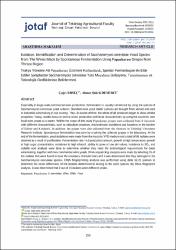| dc.contributor.author | Demirci, Ahmet Şükrü | |
| dc.contributor.author | Erseç, Çağrı | |
| dc.date.accessioned | 2023-05-06T17:23:40Z | |
| dc.date.available | 2023-05-06T17:23:40Z | |
| dc.date.issued | 2023 | |
| dc.identifier.issn | 1302-7050 | |
| dc.identifier.issn | 2146-5894 | |
| dc.identifier.uri | https://doi.org/10.33462/jotaf.1124694https://doi.org/10.33462/jotaf.1124694 | |
| dc.identifier.uri | https://search.trdizin.gov.tr/yayin/detay/1153418 | |
| dc.identifier.uri | https://hdl.handle.net/20.500.11776/12230 | |
| dc.description.abstract | Especially in large-scale commercial wine production, fermentation is usually carried out by using the species of Saccharomyces cerevisiae yeast cultures. Standard wine yeast starter cultures are brought from abroad and used in industrial winemaking in our country. Thus, in course of time, the wines of all producers began to show similar properties. Today, studies focus on terroir wines production with local characteristics by using the countries' own local wine yeasts as a starter. Within the scope of this study Papazkarası grapes were collected from 4 vineyards with different characteristics, such as viticulture practices, microclimatic conditions and locations in the borders of Edirne and Kırklareli. In addition, the grapes were also collected from the vineyard in Tekirdağ Viticulture Research Institute. Spontaneous fermentation was done by crushing the collected grapes in the laboratory. At the end of the fermentation, yeast isolations were made from the musts to YPD medium and a total of 66 isolates were obtained as a result of purification. Fermentation rate, H2S production amount, growth at high temperature, growth at high sugar concentration, resistance to high ethanol, ability to grow at low pH values, resistance to SO2, and volatile acid analysis were done to determine whether they meet the technological requirements for basic winemaking, together with two commercial wine yeasts. DNA sequencing analyzes were made by selecting 15 of the isolates that were found to have the necessary characteristics and it was determined that they belonged to the Saccharomyces cerevisiae species. DNA fingerprinting analysis was performed using delta 12-21 primers to determine the strain differences of the isolates determined to belong to the same species. By DNA fingerprint analysis, it was determined that 9 out of 15 isolates were different strains. | en_US |
| dc.language.iso | eng | en_US |
| dc.identifier.doi | 10.33462/jotaf.1124694https://doi.org/10.33462/jotaf.1124694 | |
| dc.rights | info:eu-repo/semantics/openAccess | en_US |
| dc.subject | Papazkarası | en_US |
| dc.subject | S. cerevisiae | en_US |
| dc.subject | Wine | en_US |
| dc.subject | DNA | en_US |
| dc.subject | Yeast Papazkarası | en_US |
| dc.subject | S. cerevisae | en_US |
| dc.subject | Şarap | en_US |
| dc.subject | DNA | en_US |
| dc.subject | Maya | en_US |
| dc.subject | Karakterizasyon | en_US |
| dc.title | Isolation, Identification and Determination of Saccharomyces cerevisiae Yeast Species from The Wines Made by Spontaneous Fermentation Using Papazkarası Grapes from Thrace Region | en_US |
| dc.type | article | en_US |
| dc.relation.ispartof | Tekirdağ Ziraat Fakültesi Dergisi | en_US |
| dc.department | Fakülteler, Ziraat Fakültesi, Gıda Mühendisliği Bölümü | en_US |
| dc.identifier.volume | 20 | en_US |
| dc.identifier.issue | 1 | en_US |
| dc.identifier.startpage | 155 | en_US |
| dc.identifier.endpage | 165 | en_US |
| dc.institutionauthor | Demirci, Ahmet Şükrü | |
| dc.institutionauthor | Erseç, Çağrı | |
| dc.relation.publicationcategory | Makale - Ulusal Hakemli Dergi - Kurum Öğretim Elemanı | en_US |
| dc.identifier.trdizinid | 1153418 | en_US |



















